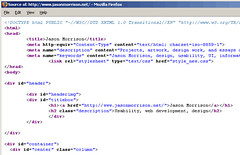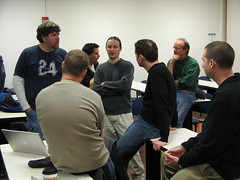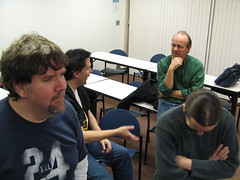 The Word Wide Web has grown at an astounding pace and is pretty ingrained in a lot of our daily lives – you’re reading it right now. Part of the reason it has been so successful has been the flexibility and ease of use of the basic language of web pages, HTML.
The Word Wide Web has grown at an astounding pace and is pretty ingrained in a lot of our daily lives – you’re reading it right now. Part of the reason it has been so successful has been the flexibility and ease of use of the basic language of web pages, HTML.
Most web sites are developed in HTML 4 (first released in 1997) or XHTML (from 2000). Considering the rapid change all around the web, why hasn’t there been a new version, and what’s next for the Web? One reason we haven’t seen new versions is the aforementioned flexibility. There have been plenty of developments, from blogging software and other content management systems on the server side to CSS, AJAX, and embedded Flash video on the front end.
Microformats are a part of this and will be a big part of the future too. But all the web developers in the house should get up to speed on HTML 5, which looks to be the future of the Web.
I’ve been watching what the Web Hypertext Application Technology Working Group (WHATWG) has been doing with HTML 5 ever since I took a gander at the W3C’s XHTML 2 spec and figured out that they were mostly adding annoyance and removing backwards compatibility. Guys I respect, like Eric Meyer, seemed to agree. The WHATWG decided to work on their own ideas and came up with HTML, which was eventually adopted by the W3C as well.
I haven’t taken a look in a while but Marcia Zeng mentioned the HTML 5 spec in an email recently and it got me interested in checking back in. I have to say, for the most part, it’s looking very interesting.
So I decided to put together a quick list of my top 10 new things in HTML 5:
- The <nav> element. This will be great for the billions of navbars we web developers have been coding up for the past 10 years. Things like this will help reduce the problem of div soup and make structure more apparent.
- The <header> and <footer> elements. See the last entry and add in the billions of page headers and footers we’ve produced as well. Semantically meaningful tags like these can only help browser plugin writers, search engine programmers, and other hackers to come up with cool new features.
- The death of the dreaded <font> tag. This should have been banished as soon as CSS was widely supported. It was a pain in the rear to use back in the 1990s when coding by hand, and was even worse when inserted by GUI tools like FrontPage.
- The continued usefulness of the <img> element. You may be wondering how we could make web pages without the image element, but XHTML2 only included it grudgingly, recommending everyone use <object> instead. The problem is that just about anything could be an object, the tag is almost meaningless. Why not replace all tags with <thing>?
- The <audio> and <video> elements. There’s been some controversy about this, because the W3C originally recommended use of the open source Ogg formats but later recanted. Still, it will be nice to embed audio and video as easily and consistently as images are used now.
- New <input> types for dates, urls, etc. When you have a form that requires a user input a date or some other specialized data, you choices have been to present a plain text input or jazz things up with JavaScript to make it a bit more usable. HTML 5 adds specific types for these cases.
- The conenteditable API. This will be really interesting if it’s fully supported. In Tim Berners-Lee’s original vision for the web, documents would be easily editable. Wikis get us almost there, but a standard editing API would be even better.
- A required attribute for form inputs. This won’t mean we can stop checking incoming data on the server side (users can still POST arbitrary data with the right tools) but it should remove the need for millions of little field-checking JavaScripts.
- The <figure> and <legend> elements. This will make it a little easier to associate captions and other text to images. Look for CMSs and image search engines to take advantage of these tags.
- An open development process. Want to keep an eye on development? Got an idea or concern about the spec? Hop on one of the mailing lists. Open standards are great for promoting compatibility and competition, so open development of the standards just makes sense.
 I wrote a little earlier about what I was looking forward to in HTML 5. I haven’t had a chance to really collect my thoughts about XHTML 2 vs HTML 5, to be honest I’d be happy to see progress on both fronts. I do have to say I lost interest in XHTML 2 early on when it seemed they were throwing some baby out with the bathwater. HTML is not the cleanest, most elegant language but the ease of picking it up is part of why the web grew so quickly. Even if that has forced browsers to cope with millions of pages of clunky, broken HTML.
I wrote a little earlier about what I was looking forward to in HTML 5. I haven’t had a chance to really collect my thoughts about XHTML 2 vs HTML 5, to be honest I’d be happy to see progress on both fronts. I do have to say I lost interest in XHTML 2 early on when it seemed they were throwing some baby out with the bathwater. HTML is not the cleanest, most elegant language but the ease of picking it up is part of why the web grew so quickly. Even if that has forced browsers to cope with millions of pages of clunky, broken HTML.

